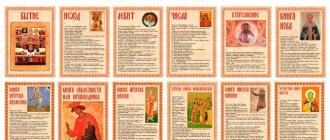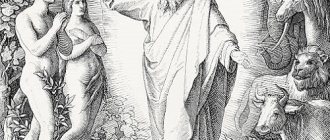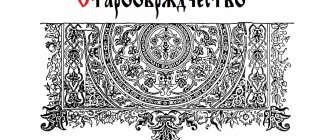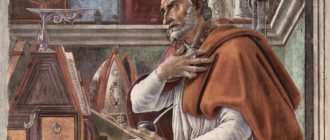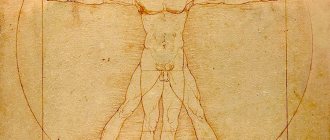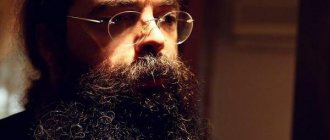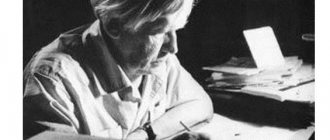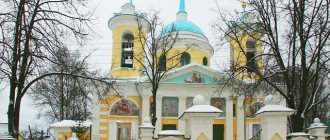Apocrypha (from ancient Greek - “hidden, hidden”) are works of late Jewish and early Christian literature that were not included in the biblical canon. The concept of “apocrypha” originally referred to the works of Gnosticism, which sought to keep its teachings secret. Later, the term “apocrypha” was attributed to early Christian texts that were not recognized as “inspired”: the Gospels, Epistles, Acts and Revelations that were not included in the Bible are considered by the Church to be “extraneous” or “non-canonical”, that is, apocrypha proper.
General definitions
According to the definition of the “Church Dictionary” by P. A. Alekseev (St. Petersburg, 1817), these are “hidden, that is, books published unknown from whom, or that are not publicly read in the church, as the Holy Scripture is usually read. Such books are all those that are not in the Bible.” That is, apocryphal books for the most part distort the principles of revealed teaching, and they cannot generally be recognized as divinely inspired (for example, due to the too strong element of human wisdom). Therefore, these books were mercilessly persecuted by the Fathers of the Church and were not included in the canon of revealed books of the Old and New Testaments (the Bible).
There are apocrypha that slightly diverge from Christian doctrine and, in general, confirm the Holy Tradition of the ancient Church, for example in iconography and worship: there is an apocrypha called the “Proto-Gospel of James” - it is not recognized by the Church as inspired scripture, but is accepted as evidence of Church Tradition. And most of the feasts of the Mother of God - the Nativity of the Virgin Mary, the Entry into the Temple, and partly the Annunciation (this was reflected in the iconography) are confirmed by the Proto-Gospel of James. This text is called apocrypha not in the sense that it contains something contrary to Holy Scripture. In many ways, it is simply a fixation of Church Tradition.
"The Gospel of Thomas": the revival of sparrows and the death of the teacher
Each chapter of The Gospel of Thomas describes one of the miracles performed by the child Jesus. It also discussed in detail his stay with his family in Egypt - an episode only briefly mentioned in the New Testament. Two-year-old Christ and his family lived with a young widow who sheltered them. One day he began throwing salted fish into a basin, which immediately released salt and came to life (researchers believe that this may be a hint at the revival of Egyptian mummies, as well as future miracles of the resurrection of people).
The neighbors suspected the holy family of sorcerers, so Joseph, Mary and their child had to move. At the age of three, Jesus was walking through the city and saw a teacher giving a lecture to his disciples. Then he threw grain to the twelve guest sparrows sitting next to him - the birds began to fight for food and eventually fell right on top of the teacher. The teacher grabbed the Savior by the ear, but he told him the meaning of his leprosy - this was a hint of strife among his students; here also a parallel was implied with the future twelve apostles of Christ. For this prank, young Jesus and his family are again driven out of the city, and in the next chapter they move to Nazareth.
In a new place, five-year-old Jesus, playing, built small ponds, and in them he made twelve clay sparrows. The neighbors were outraged by his action - after all, it was Saturday, holy for Jews, on this day nothing could be made. Joseph had already begun to scold his child, but Jesus revived the sparrows, and they began to fly and praise God.
All the Jews were amazed, but one of the boys began to destroy the ponds of Christ. Then he called him “a wicked, ignorant sodomite” and cursed him, so much so that he immediately fell and died. This apocryphal episode was known to Muhammad through the Arabic Gospel of the Infancy of the Savior and even became part of the Koran: “O Isa, son of Maryam! Remember the mercy I showed you and your mother. I supported you with the Holy Spirit (Jibril), thanks to which you spoke to people in the cradle and as an adult. I taught you the Scripture, wisdom, Taurat (Torah) and Injil (Gospel). By My permission you made statues of birds from clay and blew on them, and by My permission they became birds” (5.110).
The hatred and misunderstanding towards the child Jesus only intensified after this act (forming a parallel to his persecution as an adult). A few days after the miracle with the sparrows, one of the children hit Christ on the street (in other versions, he threw a stone or crashed into him). However, as soon as the boy did this, he immediately fell dead. Then the young man's parents complained to Joseph about Jesus, but instead of resurrecting the murdered boy, Christ blinded his parents for their insolence. Then Joseph grabbed his stepson by the ear, to which Jesus said: “You don’t know who I am, but if you knew, you wouldn’t make me angry.”
Then the parents decide to send Christ to school. The teacher was amazed at the child’s knowledge, but ordered him to first learn the alphabet. Then Jesus began to predict the future of the teacher (sad, and apparently relating to all Jews who would be punished in the future for crucifying the Savior). Afterwards, Joseph nevertheless took his son to study writing with a second teacher. However, here too Christ began to be willful. As soon as the teacher hit him on the head (which was the norm in schools at that time), the godman told him: “I should teach you, not you teach me.” After this, he told him the entire alphabet by heart and discovered the secret meaning of the first letter (alef). The teacher recognized God in Jesus, and he healed all the people around them from all illnesses.
In the next story, Christ, along with other boys, jumped from the roof of a house. A neighbor boy jumped and fell to his death. The boy's parents thought that it was Jesus who pushed him, and in order to refute this, the Son of God forced the child to resurrect and tell him that this was not true.
A similar miracle happened a few days later. A boy, Christ's neighbor, was chopping wood and accidentally cut his leg (in those days this meant death from sepsis). Then the young Savior touched his foot and healed him. The crowd immediately believed that he was God. In the next episode, six-year-old Jesus, at the command of his mother, went to draw water into an earthen jug. However, people crowding around the well accidentally broke the vessel. Then the young Christ took water into his cloak, demonstrating another miracle.
Then the God-man went with Joseph to sow wheat. The harvest from what Christ sowed turned out to be a hundredfold - the family distributed the grain to the poor and orphans.
The following episode describes the profession of carpentry mentioned in the New Testament for Joseph and his son. When Christ was eight years old, he heard that his father was asked to make a bed, but Joseph did not have long enough boards for this. Then Jesus took hold of a piece of wood, pulled, and miraculously lengthened it.
After this, Joseph decides to send Christ to school for the third time. The boy sabotaged his lessons and refused to study. Then the teacher became enraged and hit Jesus on the head - it’s easy to guess that the teacher instantly paid for this offense with his life (however, in the end, the Son of God resurrects all those killed by him in this apocrypha). Joseph was afraid that the townspeople would be outraged by the behavior of his son, and ordered Mary to put him under house arrest. However, his friend, also a teacher, came to Joseph and offered to transfer the boy to home schooling.
Christ for the fourth time began to tell his wisdom to the teacher, instead of listening to him, but he did not beat him. On the contrary, he was so amazed by the child’s knowledge that he called many people, and they all admired the schoolboy’s extraordinary sermon.
In the final chapters of The Gospel of Thomas, Jesus heals a man who was bitten by a viper by simply blowing on his wound - and the snake then dies on its own; he also resurrects a seriously ill young man and revives a construction worker who died due to an accident. The apocrypha ends with the story of how the already twelve-year-old Jesus and his parents return to Jerusalem for Easter. On the way back, Joseph and Mary only think that their son is coming with them, but in fact he secretly returns to Jerusalem and preaches in the temple to all the teachers and elders.
In another similar apocrypha, “The Book of Joseph the Carpenter,” created in the 4th–5th centuries in Egypt, the author no longer shows the miracles of the young Christ, as in the “Gospel of the Childhood of Thomas,” and does not attribute them to the Virgin Mary, as in the “Nativity Story of Jacob.” Mary,” but ennobles Joseph—for example, by saying that he was ninety years old at the time of Jesus’ birth, which means he could not be the biological father of the Savior. This book tells in detail about Joseph’s sons from previous marriages—Christ’s half-brothers—and also describes in detail the death of Elder Joseph. This information was extremely valuable for theologians, since it refuted the popular point of view of opponents of Christianity, who reasoned that since Jesus had brothers, the Virgin Mary did not remain a virgin throughout her life.
Fighting the Apocrypha before the Nativity of Christ
Apocryphal books arose long before Christianity. Soon after the return of the Jews from Babylonian captivity, the Old Testament priest Ezra made an attempt to collect (and separate from the false apocrypha) all the holy books, then still scattered and partially lost. With his assistants, Ezra managed to find, correct/translate into modern language, supplement and systematize 39 books (in the Tanakh of the Jewish tradition they were artificially combined into 22 books - according to the number of letters in the Hebrew alphabet). Those apocryphal books that contradicted the selected books, diverged from the traditions of the Old Testament legend, were infected with pagan myths and superstitions of neighboring peoples, containing occult practices and magical spells, as well as books that did not have religious value (household, entertaining, children's, educational, love, and other nature), were strictly eliminated (sometimes mercilessly destroyed) and were not included in the Old Testament, and later in the Christian Bible. Later, some of these apocrypha nevertheless became part of the Talmud, Mishnah and Gemara used by Judaism.
Apocrypha options: transformation into pigs and death jumps
In some versions of the three childhood gospels discussed in this article, another story appears, possibly coming from Ethiopian collections of apocryphal tales. In it, Jesus rides in front of other children in the sun's rays. They, carried away by his fun, try to do the same, but fall, breaking their arms and legs.
The Savior, of course, heals them - however, in some versions of the text the author indicates that Christ foresaw the future, and therefore specifically tempted other children so that they would suffer by breaking their limbs.
In European manuscripts there are numerous versions of the stories listed above, in which they become even more fantastic. For example, in the episode with the hiding children, they climb into the oven, and Jesus asks their parents what is there. In response, they tell him that there are pigs there, and, opening the valve, they are surprised that the guys really turned into pigs. However, Jesus immediately casts a spell on them so that he can finally play with someone.
In another version, a townsman, afraid for his son because of Jesus, locks him in the house, but Christ rescues his playmate by pulling him right through the keyhole.
In an alternative version of the scene with the broken pot at the well, it is deliberately broken by boys who do not like Jesus. In response, the Son of God calmly puts it back together from the fragments and hangs it to dry on a ray of sunlight (a medieval artist misunderstood this word and turned the ray into a wooden beam). The boys beat their pots to mold them back together, as Christ had just done, but nothing works out for them - then the Savior repairs their pots and also hangs them on the beam.
The story of jumping off the roof also has an alternative - in it, children jump from slides, which also leads to their death.
In many versions of the dyer's apocrypha, Jesus even becomes his apprentice. In this version, seven-year-old Christ was impatient to quickly go home from his hated work, and out of anger he threw all the fabrics into a vat of indigo. The upset dyer began to scold the disobedient student, but Christ, pulling the fabrics back, miraculously changed their colors to the required ones (in some versions, the Virgin Mary, annoyed with the behavior of her son, asks him to do this). The episode with the vat was especially loved by the medieval dyers' workshop, who considered Jesus one of the patron saints of their craft.
In addition, in some medieval illustrations to the early Christian apocrypha about the childhood of the Savior, he helps his parents with homework, washes clothes, lights the fire, or serves it on the table.
The tradition of such images, where the young Jesus is busy with housework, survived until recently. In them, the Holy Family appears as an ideal for every family, and the diligent youth Jesus (who, for example, sweeps the floors) becomes a model of behavior for any child.
In Russia since the end of the 18th century. sometimes they painted instructive icons on the plot of the “Physical Labor of the Holy Family” according to European models: in them Jesus helps his stepfather Joseph work on wood, and the Virgin Mary is engaged in yarn. They were also widespread in the Soviet period during renovationism, a movement that tried to adapt Orthodoxy to new socialist realities.
The hammer with which Christ worked could resemble the hammer of the Soviet coat of arms on such icons, and the icon itself was renamed in the spirit of the slogans of a socialist poster: “The Holy Family is a teacher of labor.” This image had a didactic function and showed the diligent and obedient youth Jesus as a model of behavior for a Soviet child.
Surprisingly, the apocrypha has survived to this day not only thanks to memorable stories about the childhood of Christ and illustrations to them, but also because new texts of this kind appeared even in the 20th century. For example, in 1910 in Germany, a publisher claimed to have found an ancient Coptic manuscript about the childhood of Christ, which he himself translated into German. It told on behalf of the Egyptian doctor Benan, allegedly a childhood friend of Jesus, how the Savior was raised by a certain Egyptian astronomer, and also how he was then initiated into the secret art of healing.
Ten years later, scientists realized that this was a fake, but today it can also be considered as an original literary monument, showing what an indelible impression the authentic apocrypha about the childhood of Christ made on connoisseurs of ancient literature in the 20th century.
Deuterocanonical books
After the death of Ezra, his followers (zealots of piety) continued their search, and those books that were found were relevant and those that were written in subsequent centuries (for example, the Maccabees) were selected by them as inspired. But the rigor and meticulousness of the selection, as well as the indisputable authority and traditions of Ezra, did not allow innovations to be introduced into the established canon of the Holy Books. And only in the fairly free and enlightened city of Alexandria, where there was a rich library of antiquity, when translating the Old Testament books into Greek, 72 Jewish interpreters and translators, after deep study, diligent prayers and debates, added (in the Greek text) to the previous 39 books 11 books. It was this version (Septuagint) that became the main one for Christians who spoke predominantly Greek in the first centuries of Christianity.
When Protestants, using ancient handwritten originals, began to translate the Bible into modern national languages, they discovered the absence of these 11 books in all Jewish texts and hastened to declare these books apocrypha (although they did not prohibit them, but only declared them of little importance). It should be noted that even some canonical books (which do not confirm their views) raise doubts among Protestants.
These 11 non-canonical (deuterocanonical) books, that is, books not included in the original canon of Ezra, are revered in Orthodoxy in the same way as all other books of the Bible; they are also used during public worship (read in proverbs), along with the canonical ones. Nowadays, thanks to the successes of biblical archeology, Jewish texts previously considered lost have also become known for some books.
Medieval “Childhood of the Savior”: how a palm tree gets to heaven
In the 9th–10th centuries, new, Latin versions of the Gospels of Christ’s childhood appeared, which were then translated into the national languages of Europe. In the medieval “Book of the Birth of the Graceful Mary and the Childhood of the Savior”, in the form of correspondence between Jerome, an opponent of the apocrypha, and the bishops (false, of course), on behalf of the former, it is said that the book was written by the Evangelist Matthew himself in Aramaic, and as if Jerome himself translated this work, to cast aside all doubts about hitherto unknown episodes in the life of the Savior and his mother. Matthew, one of the four authors of the history of the life of Jesus, was as indisputable an authority as Jerome, an expert in the Scriptures and its languages. Since Matthew was not actually the author of this Gospel, scholars began to call the apocrypha the “Gospel of Pseudo-Matthew.”
Compared to the late ancient apocrypha, it is even more amazing for the reader - Jesus works miracles in it not from the age of five, as in early sources, but from infancy, even the most powerful people and animals are subordinate to him, the Roman and Egyptian authorities are subject to him, not to mention already about heaven, and fantastic creatures live on earth. In addition, since the fight against paganism in the 10th century was no longer relevant, the devil himself becomes the main enemy of Christ, and even the boy who destroys the dams of Jesus is called the devil.
“The Gospel of Pseudo-Matthew” begins with stories about Mary’s ancestors, her marriage to Joseph (the right to marry was played out by lot - Joseph miraculously flew out a dove from his staff, indicating that he should be with Mary), about doubts Joseph regarding Mary's virginity and subsequent testing in the temple with bitter water. Christ's first miracle is described in the story of a midwife who doubted Mary's virginity, for which she paid with her own hand (and was later healed by Jesus).
The second miracle of the infant Christ occurs on the way to Egypt - the holy family decides to rest in the shadow of a cave, when it suddenly turns out that this place is inhabited by a great many dragons. Everyone is scared and wants to run, but Jesus gets away from his mother and the dragons begin to bow to him. Leopards and lions come out and also worship the true God, and then even accompany the family, showing the right path.
While resting in the desert on the third day of the journey, Mary wanted to taste the fruit from a very long palm tree, since there was nothing to drink, but Elder Joseph could not climb so high. Then Christ made the tree bend down and everyone was able to be satisfied with the fruits. A source of water opens under the roots of the palm tree, and, as if in gratitude for this service, Jesus, with the help of an angel, carries a branch of this palm tree to heaven to plant it there.
Then Christ shortened the family's journey from thirty days to one, and they immediately arrived in Egypt. When the family entered the local pagan temple, all the idols in it immediately fell to the ground, and the mayor himself came with an army to deal with it. However, instead of attacking Mary and the baby, he bowed to them and recognized Jesus as the true God.
These new episodes are replaced by those already familiar to us from earlier apocrypha: the miracle of clay sparrows and the punishment of the boy who destroyed the dam, here the “son of the devil”; the murder of the “son of perdition”, who ran at Jesus - however, in this version the Savior resurrects him, “taking him by the ear” (and in the illustration he does this completely reluctantly, with a kick); confrontation with teachers; a child falling from a roof and being resurrected; miracle with water in a raincoat; miracle with multiplication of harvest. Then a new story is told about a lioness in a cave, which was tamed by the eight-year-old Christ - he crossed the river, which parted before him, right along with the lions, and entered the city with them, frightening the inhabitants.
Afterwards there are familiar stories again - about helping Joseph with a carpentry order, the murder of a teacher, healing from a snake bite, as well as a variation on the theme of reviving the dead - the resurrection of a person who died from illness with the help of Joseph's handkerchief. The apocrypha ends with the following phrase: “When Jesus slept, day and night the light of God shone upon him”; she emphasizes his supernatural abilities.
The fight against the apocrypha after the Nativity of Christ
With the rise of Christianity, there was an even greater need to separate the officially accepted books of the Bible from the various alternative apocryphal interpretations written at different times and by different people. Some of them were written by completely pious, albeit naive, people who wanted to explain and supplement the Holy Scriptures in their own way (for example, “The Virgin’s Walk through the Torments” describes the descent of the Mother of God into hell and then her representation before the throne of the Son). Other apocrypha were born in various widespread early Christian sects, and heretical movements and in Gnosticism using Christian themes. There were also authors who specifically, allegedly on behalf of the apostles revered in Christianity, compiled and distributed “messages” that were compromising the official Church, which, in their opinion, hid the originally true teaching. Therefore, Christians at all times tried to defend, from their point of view, the true “purity of their faith,” and at all times, at councils, they compiled lists of renounced books (apocrypha), which were forbidden to be read, and which were searched for, torn, burned, or cleared/washed off parchments apocryphal texts and other palimpsests were written.
In modern Christianity, only 27 books are included in the New Testament canon and are recognized as inspired books, which, according to the church, were written directly by the apostles (secular witnesses of Christ). The composition of the New Testament canon is enshrined in the 85th Apostolic Canon. Together with the books of the Old Testament, they form the Christian Bible, which contains a total of 77 books. It is all these inspired books that are considered the only authoritative source in matters of sacred history and dogma in the main Christian denominations.
However, the writing of inspired books did not stop with the death of the apostles. The Orthodox Church has been replenished and continues to be replenished with a huge number of works (writings) of the Holy Fathers, liturgical texts and descriptions of the lives of saints, which, after a careful and comprehensive study for compliance with the Holy Scriptures (Bible), are also recognized as inspired and obligatory for all Christians. Therefore, these religious books, which are not directly part of the Bible, are not considered apocrypha.
The ancient apocrypha that has survived to our time has not only historical significance, but to some extent also dialectical, since they reflect the views of Christians of the first centuries.
The apocrypha includes the so-called Old Testament apocrypha, apocryphal Gospels, Acts, Apocalypses, etc., as well as alternative “official” biographies of saints.
Apocrypha is also composed in our time, when various sects, certain “elders”, soothsayers and “miracle workers” publish and distribute religious literature that interprets in their own way the history and principles of Christian doctrine.
“Arabic Gospel of the Savior’s Childhood”: the rapist serpent and the mad Judas
In the “Arabic Gospel of the Childhood of the Savior,” written in Arabic in the 5th–6th centuries based on ancient legends, Christ appears as an even more incredible organizer of miracles than in the “Gospel of Thomas.” He begins to speak for the first time in the cradle, and then heals the old midwife from paralysis with one touch.
Seeing how powerful the baby is, she preserves the foreskin of Christ after circumcision, placing it in a vessel with oil and giving it to her son, an incense seller, for safekeeping, instructing her never to give the relic to anyone (in the Gospel of John Judas wants to sell this vessel, which here hints at his future betrayal of Christ).
It was not ordinary people who came to worship the divine baby, but magicians from the East, which was previously predicted by Zaradusht himself (Zoroastrian prophet Zarathustra). Mary gave them one of Christ's swaddling clothes, and the fire worshipers, returning to Persia, tried to burn it, but the fabric remained untouched. After the news that King Herod wants to kill Jesus, the family moves to Egypt, where another miracle occurs. As soon as Jesus was brought into the city, the earth shook there, and the local priests began to ask their pagan idol what was the matter, to which he replied: “A secret God came here, but truly He is God. And besides Him, no one is worthy to be revered as God, for He is truly the Son of God,” and then collapsed.
Satan lived in the idol, who also inhabited the son of the chief priest. He was not himself and attacked people, and now this boy chose Joseph and Mary as his target. The Mother of God was drying Jesus' diapers on poles, and the demoniac, jumping up to the holy family, became entangled in them. Their miraculous power immediately began to drive out demons from the young man, and they, turning into snakes and crows, began to jump out of his mouth. When reason returned to the boy, he began to glorify Christ.
After this, the fame of the miraculous baby spread throughout all lands. Passing by one wedding, Maria gave her child to the deaf-mute bride to hold, and she, barely cradling him in her arms, miraculously began to speak and hear. Hiding from Herod's persecution, the family moved all the time, and after living with the healed bride for three days, they moved to a new city.
There lived a virtuous wife who was raped every night by Satan in the form of a snake coiled around her womb. As soon as the wife saw the baby Jesus, she asked Mary to hold him and kiss him. After that, Satan never approached her again.
The next day, the woman saved from the serpent decided to bathe the infant Christ, and with the water remaining after washing him, she washed the leper girl, whose body had already become completely white - and she immediately recovered. Taking this girl as a companion, the holy family healed the son of the wife of the ruler of the city they came to from leprosy. In another city, Jesus cured a cursed man of impotence simply by spending the night in his house. Near another city, the family met three sisters crying over a richly decorated mule standing nearby.
Maria was surprised that such honors were given to a beast of burden, and the sisters told her a heartbreaking story: their brother was turned into a mule by witch brides, inflamed with jealousy towards each other. Placing Christ on the back of the animal, Mary asked to make the mule back a man. The mule immediately turned into a young man, and they decided to give him the companion of the holy family, a former leper, as his wife.
The family then went in search of a source of water and discovered a fig tree standing in the desert. Christ showed his family a source, Mary washed his shirt in it, and then saw that a balm appeared in that area from the sweat of the divine baby. Arriving in Bethlehem, Mary again helped a woman whose son was dying: she sprinkled him with the water in which she bathed Jesus, and he was saved. With the same water she healed a neighbor's boy, who was almost blind from an eye disease. Through the miracles of Christ, Mary also saved a child with a fever - a shirt was made for him from her son’s diapers. The mother of this child was envious, and she tried to kill the survivor: she pushed him into a hot oven, threw him into a well.
However, each time he was saved thanks to the intercession of the baby Jesus - the oven instantly cooled down, and the water in the well kept the boy on the surface. The envious woman ended up falling into the well herself, getting tangled in a rope.
Mary saved another local child, dying of illness, by putting him in bed with Jesus and covering him with the clothes of the god-man. Mary healed another woman with leprosy (and another of her acquaintances), again with the help of water. In the same city there lived a young woman who was tormented by Satan in the form of a dragon - he appeared to her and sucked the blood out of her. Mary again gave this girl some of the water in which she had bathed Jesus, as well as his swaddling cloth. Placing the veil on her head, the girl witnessed a miracle - a flame burst out of the rag and burned the dragon.
Further, the “Arab Gospel” tells how one Bethlehem youth named Judas was possessed by demons, and then he bit everyone around him or himself. One day, Jesus was taken to play with other children, and there he met Judas, who decided to kill the Lord. However, only after wounding Christ’s side did he burst into tears, and the demon in the form of a dog came out of him. This boy was the same Judas who, a few decades later, would betray the Savior.
Then the text reproduces the story about the clay sparrows - with the difference that here the seven-year-old Jesus molds various animals from clay, which he then makes move, and the birds fly, as well as eat and drink.
The same apocrypha describes a very popular story in later adaptations about how Jesus met a dyer named Salem. Running into his shop in the midst of games with other children, Christ took expensive fabrics and threw them into a vat of indigo (the most expensive dye). The enraged dyer began to scold the boy at all costs, but Christ began to pull the fabrics out of the vat, and they were now dyed exactly the colors that the artisan wanted to achieve.
This story relates to the Gnostic Gospel of Philip, in which God himself is called the dyer: “As good colors, which are called true, die along with what is painted with them, so also what God has dyed. For his colors are immortal, they become immortal thanks to his colors. So God baptizes those whom he baptizes in water.” In the apocrypha, the young Jesus himself clearly demonstrates the meaning of this parable, changing the colors, that is, human life, with the help of the Christian faith.
The Arab Gospel, unlike other sources, presents Joseph as a not very skilled carpenter, since “wherever he went, the Lord Jesus was always with him. And every time Joseph needed to do something the size of a cubit or three-quarters of a cubit, longer than that or shorter, wider than that or narrower, as soon as the Lord Jesus stretched out his hand to that thing, it became the way Joseph wanted, and his own he didn’t have to work with his hands.”
There is also a separate story about a carpenter's miracle: the king wanted to order a throne from Joseph, and when two years later it was ready, it turned out that the size of the throne was wrong. Joseph was very afraid of the king's anger, but his son simply pulled one side of the throne and straightened it.
In the next episode, the Son of God wanted to play with the neighbor kids, but they ran away from him in fear. Then he asked their mothers where they had gone and pointed to the children under the shed - but the women assured Jesus that they were just kids. Then he turned the hidden children into kids, and their mothers, fearing his power, begged for mercy and called him “the true shepherd.” In the Latin text, this episode, due to a copyist’s mistake, confusing the word “canopy” (in fornice) with “oven” (in fornace), gave rise to an additional version of the legend.
In another scene, Christ gathered all the youths around him and, laying his clothes on the ground, sat on them like a king. The children placed a crown on his head and began to behave like his courtiers. They asked everyone who walked by to honor the king. One day they carried past them a boy who had been bitten by a snake - Christ commanded the poisonous snake to come out of its hole, bow to him and suck the poison back out of the boy. After the snake healed the young man, Jesus told it to die, and so it did. And the cured boy turned out to be one of the Savior’s future disciples, Simon the Canaanite.
Then the text follows stories that are already familiar to us: about the healing of someone stung by a viper; about a boy who fell from a roof and was resurrected by Christ; about water collected in a cloak; about clay sparrows and the punishment of a boy who ruined a dam; the murdered youth who pushed Jesus; punishment of the teacher who dared to hit Christ. The Arab Gospel ends with a slightly modified story about the stay of the twelve-year-old Savior in the Temple of Jerusalem. There he talks with scientists, explaining to them the law, doctrine, and the structure of celestial bodies, talking in detail about the secrets of medicine and physics.
Of the eighteen episodes of “The Gospel of Thomas,” only eleven are repeated here, and Christ does not resurrect the boys and teacher he killed. There are also five new stories. All these scenes serve as a kind of foreshadowing of the future acts of the Son of God, which are described in the New Testament. Apparently, the "Arabic Gospel" was not rewritten from the "Gospel of Thomas", but was inspired by oral traditions, which made its stories so similar to oriental tales. This text, as we have already seen, influenced even the Koran and was distributed among Christians in Egypt (Copts) and nomadic Arabs. The “Arab Gospel” penetrated into Europe no later than the 13th century, becoming a source of inspiration for artists who illustrated the story of the Savior’s childhood.
Apocrypha of the Old Testament
Psalms of Solomon
Testaments of the Twelve Patriarchs
Ethiopian Book of Enoch
Slavic Book of Enoch
Syriac and Greek Apocalypses of Baruch (Vision of Baruch)
Ascension of Moses
Book of Jubilees
Martyrdom of Isaiah
Job's Testament
Jewish sections of the Sibylline books
Isaiah's Vision
Abrahamic Covenant, Abrahamic Revelation, Death of Abraham
Melchized
